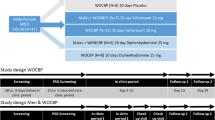Abstract
β-adrenergic receptor blocking agents (β-blocking agents) have been widely used clinically for the treatment of various cardiovascular conditions. However, β-blocking agents are liable to cause sleep disturbance, such as vivid dreams, nightmares, increased waking, and insomnia. The mechanisms of the sleep disorders are not known, but several may conceivably be responsible for these CNS-related side effects. In the present study, we hypothesized that the sleep disorders are induced by the blockade of central or peripheral β2 receptors and/or central serotonin (5-HT) receptors. To verify the hypothesis, we retrospectively analyzed the relationships between the extent of the sleep disorders and the β1, β2, or 5-HT receptor occupancies for four β-blocking agents (atenolol, metoprolol, pindolol, and propranolol). No significant correlations were observed among pharmacokinetic/physicochemical parameters (therapeutic dose, plasma concentration, plasma unbound concentration, cerebrospinal fluid concentration, and lipid solubility) and pharmacodynamic parameters (the scores of the sleep disorders such as the number of dreams). Furthermore, no significant relationship (correlation coefficient: r<0.3) was observed between β1 receptor occupancies of the drugs and the number of dreams. On the other hand, good relationships (r>0.95) were observed between central and peripheral β2 or central 5-HT receptor occupancies and the number of dreams. These findings suggest that β2 and/or 5-HT receptor occupancy is superior to β1 receptor occupancy as an index for the sleep disorders.
Similar content being viewed by others
References
T. A. Betts and C. Alford. β-Blocking drugs and sleep: A controlled trial.Drugs 25 (Suppl. 2):268–272 (1983).
T. A. Betts and C. Alford. β-Blockers and sleep: A controlled trial.Eur. J. Clin. Pharmacol. 28 (Suppl.):65–68 (1985).
T. A. Betts and C. Alford. β-Blocking drugs and sleep: A controlled trial.Primary Cardiol. Suppl. 1:201–205 (1983).
W. P. Koella. β-Blockers and CNS side-effects: CNS-related (side-)effects of β-blockers with special reference to mechanisms of action.Eur. J. Clin. Pharmacol. 28 (Suppl.):55–63 (1985).
J. B. Kostis and R. C. Rosen. Central nervous system effects of β-adrenergic-blocking drugs: the role of ancillary properties.Circulation 75:204–212 (1987).
J. B. Kostis and R. C. Rosen. Beta-blocker effects of central nervous system: A controlled comparative study.J. Am. Cardiol. 7(2A):25A (1986).
C. Dahlöf and E. Dimenäs. Side effects of β-blocker treatments as related to the central nervous system.Am. J. Med. Sci. 299:236–244 (1990).
D. E. Drayer. Lipophilicity, hydrophilicity, and the central nervous system side effects of beta blockers.Pharmacotherapy 7:87–91 (1987).
D. N. Middlemiss, L. Blakeborough, and S. R. Leather. Direct evidence for an interaction of β-adrenergic blockers with the 5-HT receptor.Nature 267:289–290 (1977).
Y. Yamada, K. Ito, K. Nakamura, Y. Sawada, and T. Iga. Prediction of therapeutic doses of beta-adrenergic receptor blocking agents based on quantitative structure—Pharmacokinetic/pharmacodynamic relationship.Biol. Pharm. Bull. 16:1251–1259 (1993).
H. Nishio, Y. Nagakura, and T. Segawa. Interactions of calteolol and other β-adrenoceptor blocking agents with serotonin receptor subtypes.Arch. Int. Pharmacodyn. 302:96–106 (1989).
G. N.-Dwyer, J. Bartlett, J. McAinish, and J. M. Cruickshank. β-Adrenoceptor blockers and the blood-brain barrier.Br. J. Clin. Pharmacol. 11:549–553 (1981).
B. Q. Thiessen, S. M. Wallace, J. L. Blackburn, T. W. Wilson, and U. Bergman. Increased prescribing of antidepressants subsequent to β-blocker therapy.Arch. Intern. Med. 150:2286–2290 (1990).
J. M. Cruickshank. How safe are β-Blockers?Drugs 25 (Suppl. 2):331–340 (1983).
J. M. A. Monti. Disturbances of sleep and wakefulness associated with the use of antihypertensive agents.Life Sci. 41:1979–1988 (1987).
K. P. Minneman, L. R. Hegstrand, and P. B. Molinoff. Simultaneous determination of Beta-1 and Beta-2-Adrenergic receptors in tissues containing both receptor subtypes.Mol. Pharmacol. 16:34–46 (1979).
O. Meirieu, M. Pairet, J. F. Sutra, and M. Ruckebush. Local release of monoamines in the gastrointestinal tract: An in vivo study in rabbits.Life Sci. 38:827–834 (1986).
Author information
Authors and Affiliations
Rights and permissions
About this article
Cite this article
Yamada, Y., Shibuya, F., Hamada, J. et al. Prediction of sleep disorders induced by β-adrenergic receptor blocking agents based on receptor occupancy. Journal of Pharmacokinetics and Biopharmaceutics 23, 131–145 (1995). https://doi.org/10.1007/BF02354268
Received:
Accepted:
Published:
Issue Date:
DOI: https://doi.org/10.1007/BF02354268



